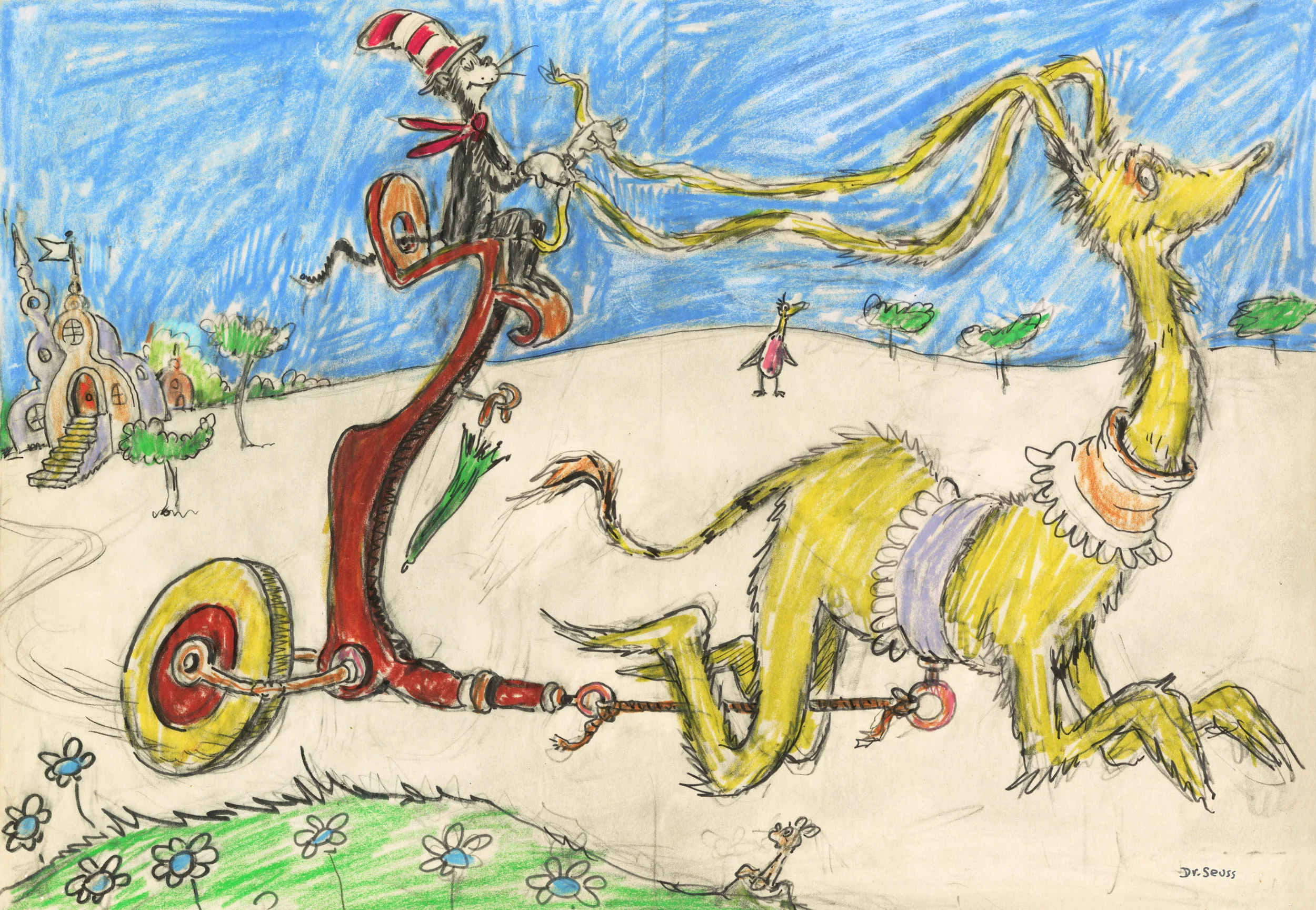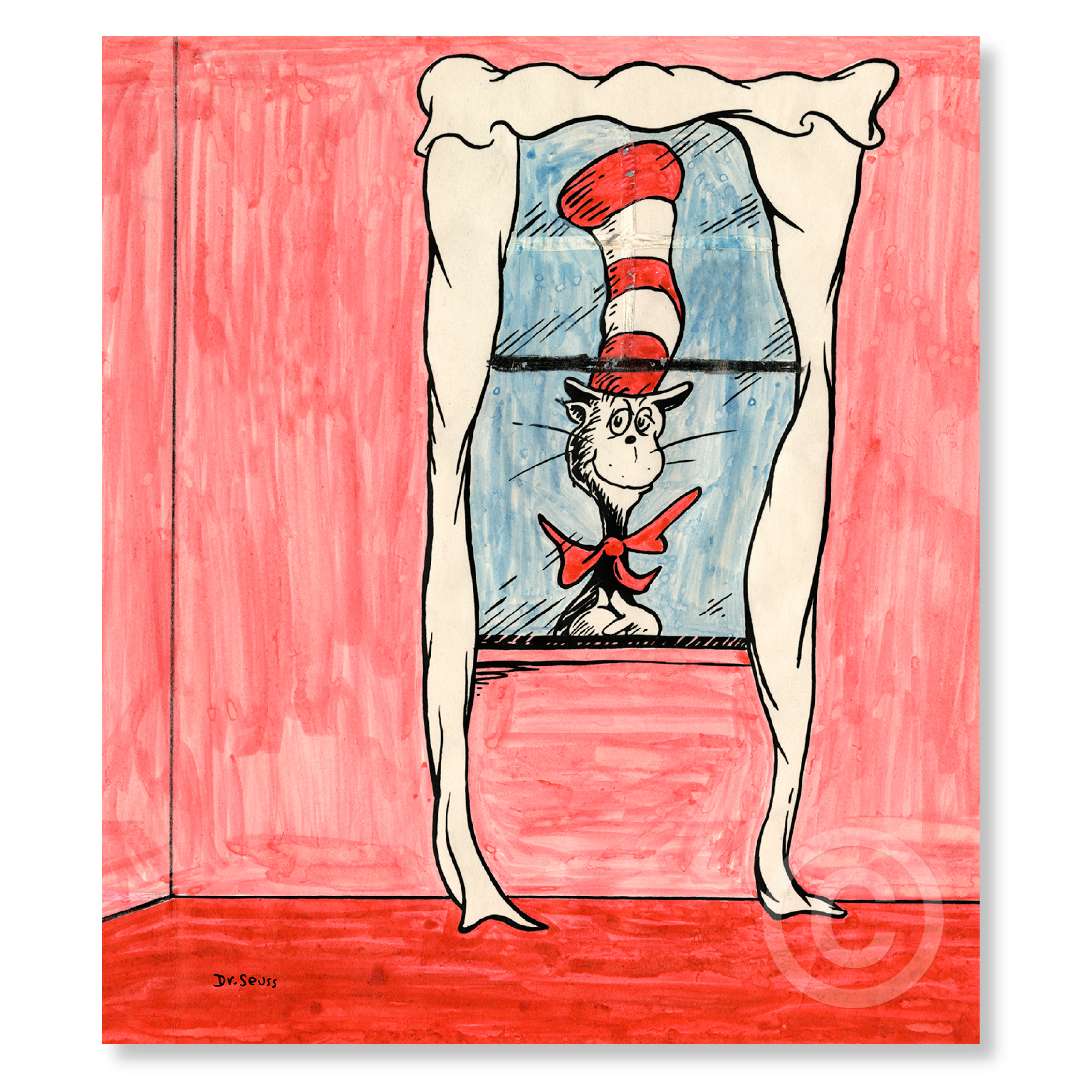THE CAT’S QUIZZER
The Cat’s Quizzer
Pigment Print on Archival Paper
Image & Paper Dimensions: 25” x 36”
Limited Edition of 850 Arabic Numbers, 99 Patrons’ Collection, 155 Collaborators’ Proofs, 5 Hors d’Commerce, and 2 Printer's Proofs
“Imagine if you can, a moment when your most valued physical trait becomes compromised, so much so that you may no longer be able to continue the only profession you have ever known.”
Nearly all of Dr. Seuss’s books are full of personal references to friendships and important milestones in his life — The Cat’s Quizzer is no exception.
Imagine if you can, a moment when your most valued physical trait becomes compromised, so much so that you may no longer be able to continue the only profession you have ever known.
Now imagine being Ted Geisel, aka Dr. Seuss, a man whose life’s work was as an artist. His eyesight was the catalyst for processing both the art being made in the world around him, and the critical ingredient in being able to make drawings and paintings himself. Until…
“Late one morning in 1975 Ted burst from his studio, shouting for Audrey. “Am I going blind?” he asked in a voice thick with fright. “I can’t focus! Everything is squiggly.””
Ted and Audrey November 23, 1976, photo by Colin Dangaard.
Used with permission.
After Audrey calmed him, she called Dr. David Worthen, the new chief of ophthalmology at UCSD’s School of Medicine. Indeed, Ted was suffering from serious cataracts and glaucoma and his eyesight was at risk. Under Dr. Worthen’s care, Ted embarked on a series of surgeries over five years to maintain his ability to see.
Despite this arduous situation, and with the thoughtful care of Dr. Worthen and the support of Ted’s wife Audrey, Ted never stopped working. What he did do was turn from his “big books” to creating shorter, less complicated Beginner Books. In 1976 it was an unexpected stunner, The Cat’s Quizzer, with Dr. Seuss’s famed “Cat in the Hat” making another appearance in this quirky Q and A.
“LOOK AT THIS FOR 2 MINUTES.”
“The beauty of Seuss is how he always wrapped life’s most salient moments into his images without ever losing his audience and without ever losing their smile.”
This Cat’s Quizzer image in particular seems incredibly relevant to Ted’s precarious situation. He was constructing a quiz for young readers to examine an image and wrote the following text — “Look at this for 2 minutes…Then turn the page.” What follows is a quiz about recognition and what could they retain from the previous drawing.
In Ted’s particular case, however, it seems more poignant than that. What, if anything, would he be able to retain through the blurred vision or potential blindness he was facing? The underlying narrative seems to point to an artist at his most vulnerable, at a moment when circumstances beyond his control could dramatically alter the trajectory of his life.
Such heady ideas are not foreign to Dr. Seuss’s seemingly whimsical and easily digestible imagery. The beauty of Seuss is how he always wrapped life’s most salient moments into his images without ever losing his audience and without ever losing their smile.
In the end, Ted persevered as he always did. His eyesight was restored and he continued to create artwork that would have a dramatic impact on our culture. The significance of that moment was never lost and his ability to continue was a gift he never squandered.
Ted Geisel after cataract surgery
CAN YOU REALLY “SEE”?
“Here, Dr. Seuss challenges us to really “see” and “savor” the most important aspects of our lives.”
This dynamic pencil drawing was done before Ted moved to his final pen-and-ink line drawing for this page of the book. Between the two images he changed the text as follows:
“Now . . . Look at this for 2 minutes. . . Then turn the page.”
Was changed to:
“Now . . . Look at this picture. Look at it hard. Then turn the page . . . .”
This subtle change takes on added meaning for all of us who know the harrowing experience he was going through with his eyesight. In life, our moments of greatest challenge are where we tend to find our greatest strength and resilience. These can be the moments when our eyes open wider and we begin to “see” the world around us in a different light. Here, Dr. Seuss challenges us to really “see” and “savor” the most important aspects of our lives.
DR. SEUSS’S CONCEPT DRAWINGS
“What is most special about Dr. Seuss’s early and middle-stage concept drawings are their ability to convey the creative impulse of the artist. Less worried about the quality of the line, in these stages it’s all about the energy and personality of the scene.”
Ted Geisel drew every page for every Dr. Seuss book he wrote. What many people don’t realize is that for each final line drawing, Ted would create multiple concept drawings leading up to the final published image. During each stage of concept development he would tirelessly refine the imagery, making subtle adjustments to characters and nuanced shifts to the scene in which they appeared.
Here we see an extraordinary example of a middle-stage concept drawing. Ted has moved from his roughest pencil sketches, which began the conceptual phase, into this more fully-realized artwork emphasizing the character’s personality, the energy of the scene, and the dramatic use of color. The spirit of the final image is intact, the details are set, and the template has been created for Ted to confidently spring from this phase to his final pen-and-ink line drawing.
What is most special about Dr. Seuss’s early and middle-stage concept drawings are their ability to convey the creative impulse of the artist. Less worried about the quality of the line, in these stages it’s all about the energy and personality of the scene.













